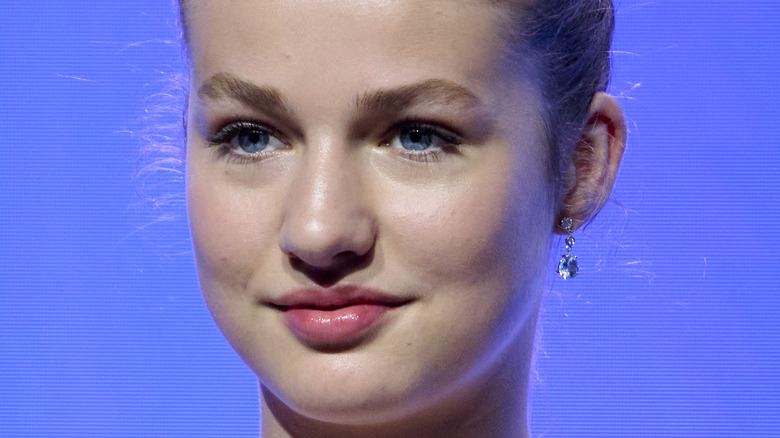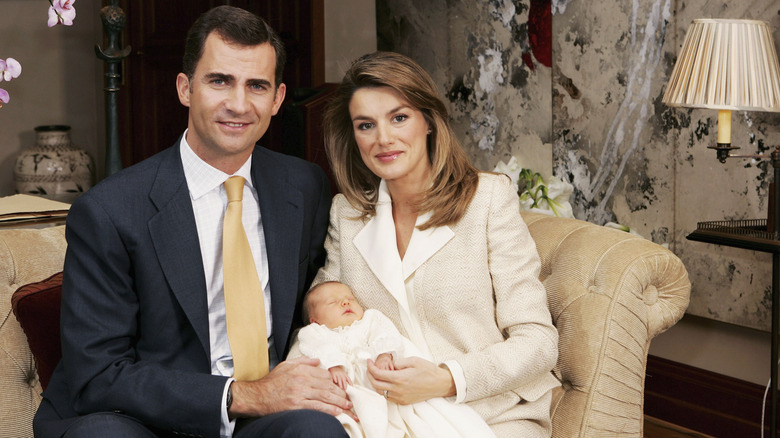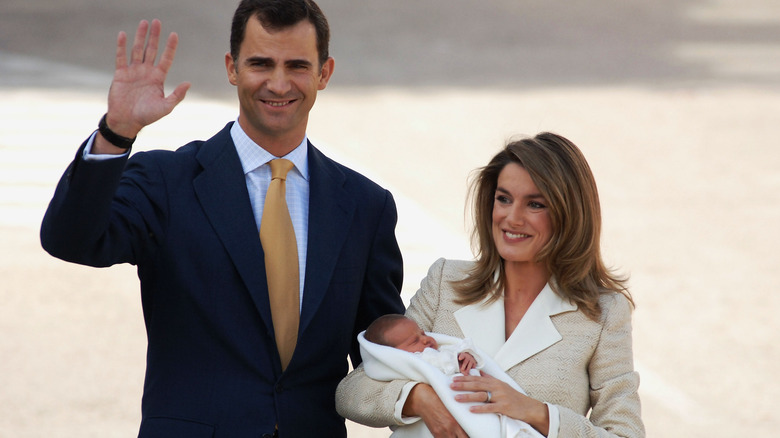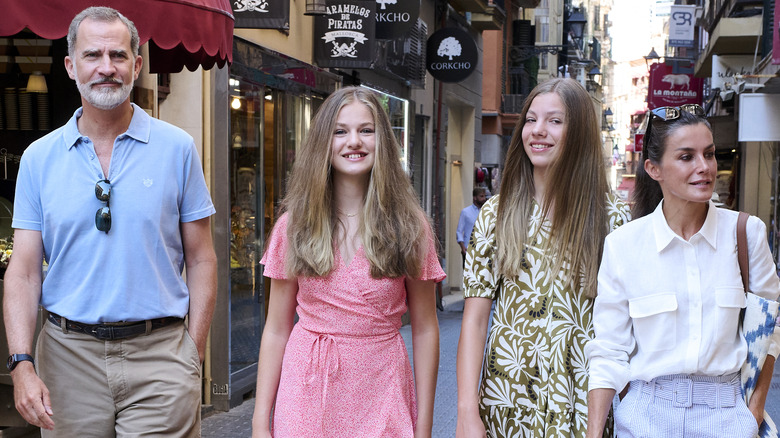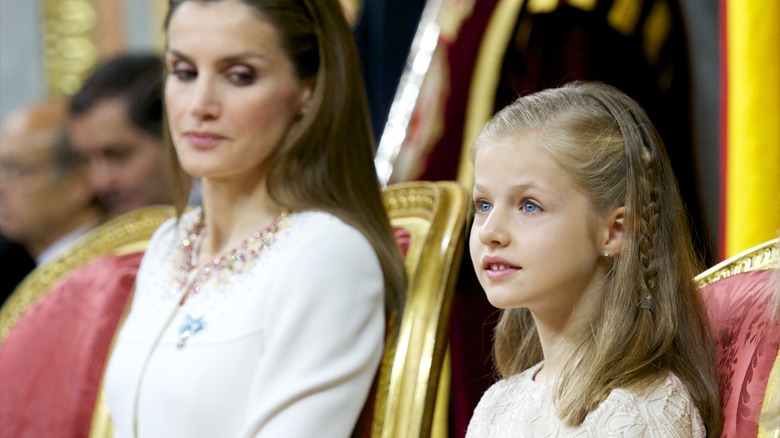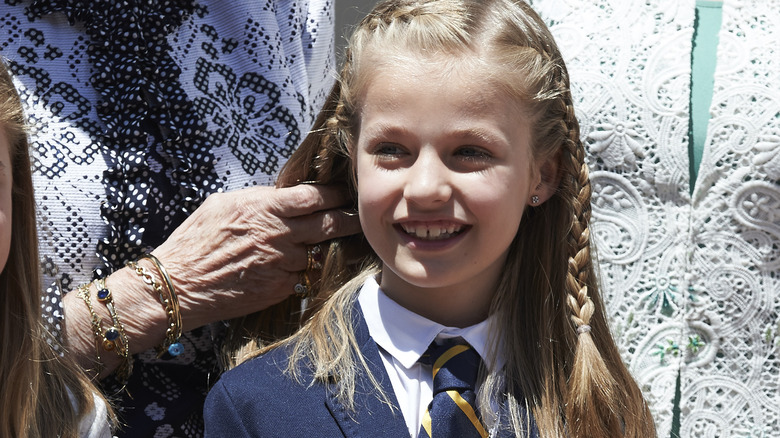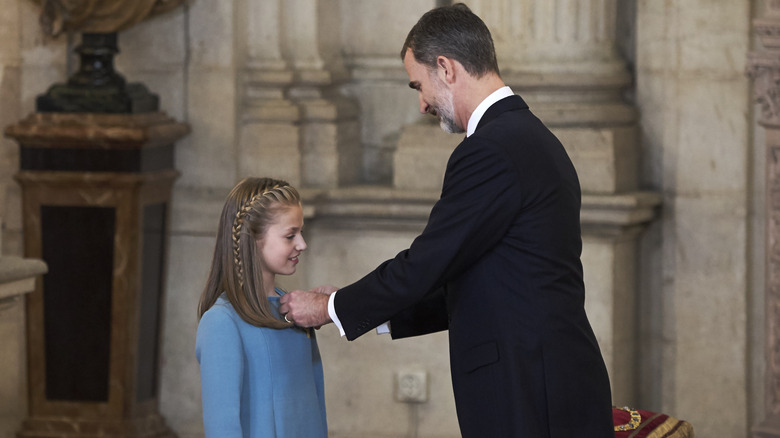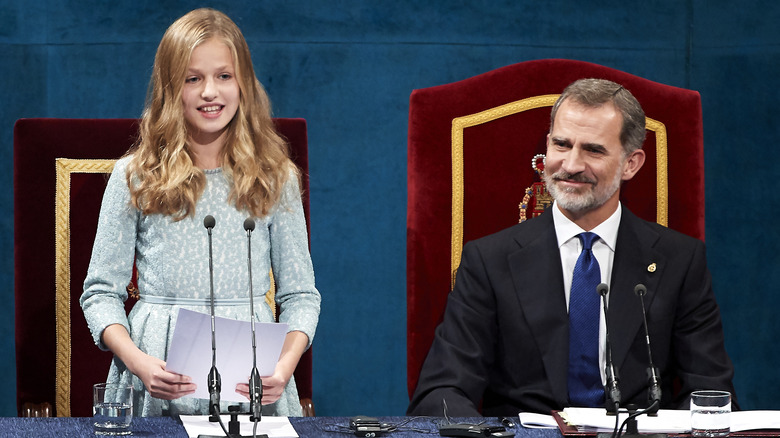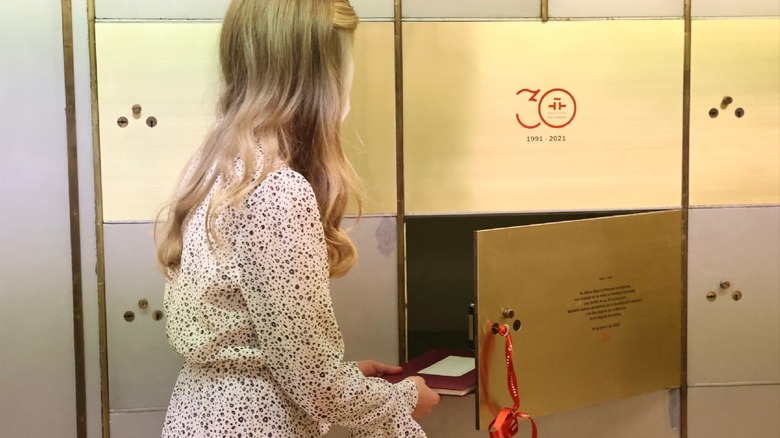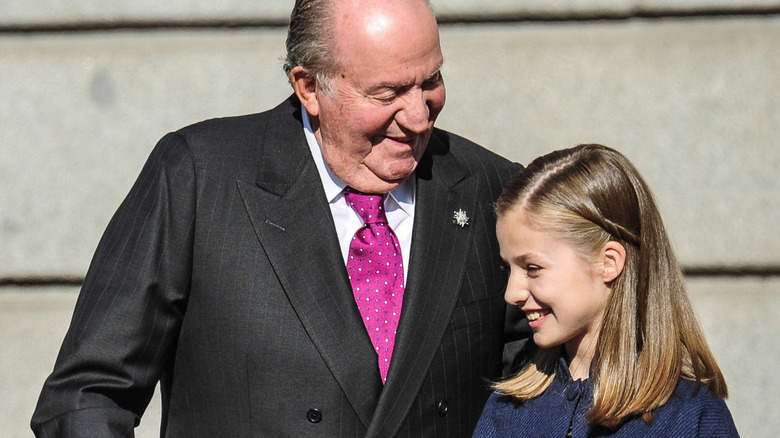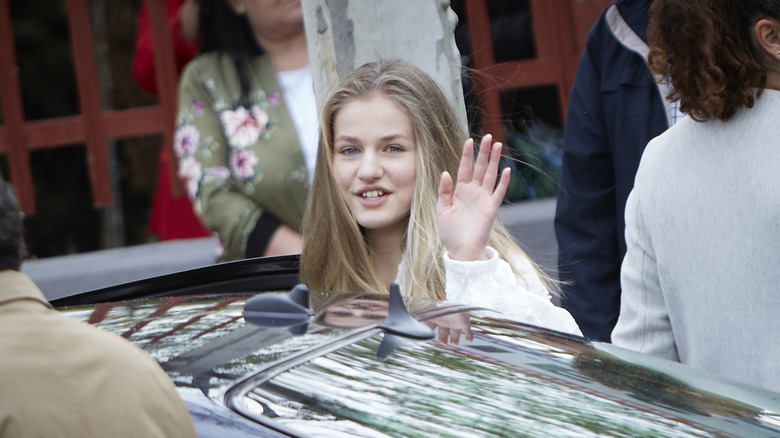The Untold Truth Of Spain's Princess Leonor
Princess Leonor, was born on October 31, 2005, as the Infanta Leonor de Borbón y Ortiz (via The Irish Times). Her parents are Their Majesties King Felipe VI of Spain and Queen Letizia, per the Spanish royal family. At the time of Leonor's birth, Felipe was crown Prince of Spain, aka the Prince of Asturias. It was only when Felipe ascended in 2014 that Leonor became a princess. Because of the circumstances under which her father came to reign (the abdication of his father and predecessor, King Juan Carlos), Princess Leonor shares with Her Majesty Queen Elizabeth II the unusual distinction among European heirs to the throne of being alive contemporaneously with both the current sovereign and the former (via Brittanica).
All of that being said, Princess Leonor is not the heir apparent, but the heir presumptive. That's because Spain's monarchy adheres to male primogeniture, by which a future-born legitimate son of a monarch could trump a living female's place in the line of succession (via Unofficial Royalty). Nevertheless, with her married parents in their fifties and not getting any younger, the royal presumption has become increasingly compelling over time. In any event, Princess Leonor has long been regarded by the Spanish people as their future queen. If she does become queen, she will be the first queen regnant (i.e., by blood) since the 1800s, per Hello! Magazine. Join us as we trace the stunning transformation of this future Queen of Spain.
Princess Leonor was not born a princess
All three of His Royal Highness, Prince William's children (George, Charlotte, and Louis) have had the title HRH prince/princess since birth, per Harper's Bazaar. Although we may take this for granted as a given because their father is the future King of England, it is, in fact, nothing more than a construct dating back more than 100 years to the reign of King George V, the grandfather of Her Majesty Queen Elizabeth II, per Tatler. In 1917, George V issued Letters Patent proclaiming that the title of prince/princess would, henceforth, be available to the reigning monarch's children and to the children of the sons of the reigning monarch.
By contrast, no such construct exists with regard to the Spanish monarchy, under which only the heir apparent or presumptive bears the prince/princess title — i.e., the crown prince/princess, per El Pais. All other children and grandchildren of the monarch are born with the title Infante or Infanta, depending on their gender assignment at birth (via Britannica). At the time of Leonor's birth in 2005, her father, then-crown Prince Felipe, was not the monarch, but rather, the heir apparent to his father, then-King Juan Carlos. Accordingly, at birth, Leonor was known as HRH Infanta Leonor and had to wait until her father ascended the throne in 2014 to use the princess title. Her younger sister, Sofia, was also born HRH Infanta and remains as such, even now that her father is king.
Even before she became an official princess, Leonor was regarded as the future queen
The Infanta Leonor was introduced to the people of Spain as a sweetly swaddled newborn outside Madrid's royal-family-friendly Ruber International Clinic (per The Irish Times). Although her future as queen has always hinged on her father's producing no legitimate male heirs, per the Spanish monarchy's order of succession, Princess Leonor has always been regarded by the people of Spain as their future queen — similar to how Queen Elizabeth had been regarded as the future monarch after her father ascended the throne, despite that she too had male primogeniture working against her (per Time).
Synonymous as she is with the future of Spain, Princess Leonor has lived her life in the public eye, per Hola. Indeed, many of her milestones have been well documented. This includes her 2006 baptism, which, in keeping with Spanish royal tradition, used holy water from the River Jordan. Throughout the years, she's also been photographed at outings to sailing regattas, social events with other members of European royalty, summers spent at the Palacio de Marivent in Mallorca, and various royal engagements.
Princess Leonor could lose her claim to the throne, although it's becoming less likely
Just as the birth of Prince William to Prince Charles and Princess Diana was a thrilling moment for many Brits because it put a cherubic face to the future of Britain, the birth of the Infanta Leonor was seen as highly auspicious in Spain (via The Irish Times). Nevertheless, even after 17 years of being Spain's next monarch, the possibility remains, however unlikely, that her father, Felipe, could produce a legitimate male heir. If he were to do so, this would bump Leonor from the order of succession (via Unofficial Royalty). The 2007 birth of her younger sister, Infanta Sofia, eliminated some degree of uncertainty regarding Leonor's status. However, it could not eliminate all of it, especially when you consider how things went down for Felipe's two sisters vis-à-vis the royal line of succession.
By the time Felipe was born in 1968, King Juan Carlos and Queen Sofia were already parents to two daughters, the Infantas Elena (born in 1963) and Cristina (born in 1965), per Hello! Magazine. Like Leonor, Elena was regarded as the heir presumptive at birth. And so it remained, even after the birth of her younger sister, Cristina. Five years into her life, however, Elena lost her status as heir presumptive — when Felipe, a legitimate male heir to the crown, was born.
Leonor became Princess of Asturias in 2014
The Spanish title of prince/princess is exclusive to the person next in line to the living monarch, per El Pais. Born while her father was still crown prince, Leonor was known as an Infanta until Felipe ascended the throne in 2014. At that point, Leonor was officially proclaimed Heir to the Throne, per the official website of the Spanish royal family. At the same time, she also acquired her title as Princess of Asturias, which, like the British title Prince/Princess of Wales, denotes that the person who holds it is the next in line to the throne. Unlike the Wales title, however, which the British monarch must bestow upon in its owner, per Town & Country, the Heir to the Throne in Spain is automatically endowed with the Asturias title upon the investiture of their parent as monarch of Spain, per Article 57(2) of the Spanish Constitution.
Accordingly, when Leonor's father, Felipe, became king on June 19, 2014, Leonor's title changed automatically from Infanta Leonor to Princess Leonor of Asturias. She also holds the titles of "Princess of Girona and Princess of Viana, corresponding to the firstborn of the Kingdom of Castile, the Throne of Aragon and the Kingdom of Navarre, whose union formed the Spanish Monarchy in the 16th century," as well as the Duchess of Montblanc, the Countess of Cervera, and the Lady of Balaguer, according to the Spanish royal family website.
The parallels between Princess Leonor and Queen Elizabeth are undeniable
In 1936, when Princess Elizabeth of York was just 10, her uncle, King Edward VIII, abdicated the British throne with no legitimate heirs to his name (via History.) Under the order of succession, the crown went to Edward's next younger brother, Prince Albert of York, who was known, from then on, as King George VI, per Britannica and Time. Since George VI was Princess Elizabeth's father, Elizabeth became heir presumptive, while her younger sister, Princess Margaret, who was known to be the more affable and outgoing of the two, looked on with what some characterize as envy (per Marie Claire).
In 2014, when Infanta Leonor was just eight, her grandfather, King Juan Carlos, abdicated the throne in favor of his son Felipe. Like Elizabeth, Leonor was, at that point, thrust into her new role as daughter of the monarch, crown princess, and heir presumptive. Like Elizabeth, Leonor is the more reserved of the two sisters, per Royal Central. Although we can't say if Sofia feels envy towards Leonor for being first in line to the throne, the parallels between Queen Elizabeth II's journey to the throne and Leonor's are still quite notable. In fact, just as Leonor's birthright to the crown could be wiped out by the birth of a younger brother, so too could have been the case for Elizabeth. Of course, we know how that went for Elizabeth. Given Felipe and Letizia's respective ages, it's quite possible history will repeat itself.
Princess Leonor's first communion was a rather low-key affair
In May 2015, less than a year after her father ascended the throne, nine-year-old Princess Leonor received her first communion, according to Hello! Magazine. Traditionally, the Spanish royal family, which is Roman Catholic, makes quite the big to-do over its family members' first communions, tending to hold them as lavish affairs at the royal palace of Zarzuela itself, and with only the one young royal family member receiving the sacrament. Nevertheless, the Princess of Asturias received her first communion at a church in a Madrid suburb (the Asunción de Nuestra Señora church in Aravaca), per The San Diego Union-Tribune. Rather than wearing a dress designed specially for the occasion, Leonor wore the same navy and gray uniform that she wore daily to her private school in Madrid. And, presumably, so did the other two dozen or so classmates of Leonor who were also there to receive their own respective first communions.
Although the presence of the king and queen as well as the emeritus king and queen made the event newsworthy, it would seem that not much else did, per Hola, which called the event "discreet and familiar." Apparently, that's how King Felipe wanted it. "Since King Felipe VI came to the throne last year, he has sought to open up the monarchy and bring it closer to Spaniards," the Union-Tribune noted at the time.
Princess Leonor was presented with the Order of the Golden Fleece, one of Spain's highest honors
In October 2015, on the occasion of Princess Leonor's 10th birthday, King Felipe VI awarded her with the Order of the Golden Fleece, per Hello! Magazine. The Order of the Golden Fleece was founded in 1430 to "defend the Roman Catholic religion, to uphold the usages of chivalry, and to ... settle all disputes between its knights," according to Britannica. Known as one of Spain's highest honors, the Order of the Golden Fleece has been awarded to only 1,200 people over the course of these last eight centuries. Prior to 2015, only three of its recipients had been female, one of whom was Queen Elizabeth II, who received the honor from King Juan Carlos.
Although the honor was first bestowed upon Leonor in 2015, the official ceremony by which she received the insignia of the Order did not occur until January 30, 2018, per El Pais. Since that day coincided with King Felipe VI's 50th birthday, and because Leonor would be turning 13 later that year — the same age at which Felipe embarked on his public life as crown prince — El Pais interpreted the occasion as the symbolic launch of Leonor's public life as crown princess. Indeed, as Felipe remarked during the ceremony, "Today, Leonor, you are taking a very important and symbolic step towards your future role" (via Hello! Magazine).
At age 13, Princess Leonor hit two important milestones
Although her receipt of the Order of the Golden Fleece in January 2018 may have marked Princess Leonor's symbolic entry into public life as crown princess of Spain, per El Pais, it wasn't until her birthday later that same year that she took an even bigger step toward that end. On October 31, 2018, the same day that Princess Leonor of Spain turned 13, she delivered her very first public address to the people of Spain, according to Town & Country.
Not only was it the princess' birthday, but it was also the 40th anniversary of Spain's Constitution (aka the Carta Magna) which Spain approved in 1978 as final severing of ties to Francisco Franco's dictatorship — which officially ended in 1975 when Franco died, and Juan Carlos became king (via The Guardian). At a commemorative event held at the Cervantes Institute in Madrid, Princess Leonor stood up and read from the Carta Magna in a "firm voice," but only after her father warmed up the crowd with his reading of the preamble, according to AP News. Perhaps not surprisingly, King Felipe was also 13 when gave his own first public address as crown prince.
Still 13 on October 18, 2019, Princess Leonor also presided for the first time over her namesake award ceremony, The Princess of Asturias Awards. Perhaps most significantly, she took that opportunity to pledge herself to the service of Spain and its people (per Royal Central).
In 2021, Princess Leonor helped her father present civilian awards to frontline workers
Throughout the year she turned 13, Princess Leonor made other official public appearances. For example, on June 19, 2019, she helped her father, Felipe, as he gave out awards in connection with the Order of Civil Merit Ceremony, per Just Jared Jr. Founded by Princess Leonor's great-great-grandfather, King Alfonso XIII on June 25, 1926, the Order of Civil Merit was intended to recognize and reward the good work of public servants in service of the nation, per Government of Spain.
These days, the Order has been broadened to include Spanish nationals who aren't necessarily public servants, but who have provided an important service to the nation through "extraordinary works, beneficial initiatives or exemplary constancy in the fulfillment of their duties" as well as non-Spanish nationals in service of Spain. What is most significant here is that "His Majesty the King" is the Order's "Grand Master," with all awards being "conferred in his name." Accordingly, in giving her father a hand with these awards, it looks as if Princess Leonor may be preparing for her own future as the Order's next Grand Master.
Princess Leonor was on hand once again at 2021's Order of Civil Merit Ceremony, during which the awards focused on recognizing the contributions of front line workers during the COVID-19 pandemic, per ThinkSpain. Recipients included not only healthcare workers but also "manufacturers, food producers, and transport and distribution drivers."
Her first solo royal engagement took place in March 2021
On March 24, 2021, Princess Leonor checked off yet another important milestone in her potential journey toward the Spanish throne by conducting her first solo engagement as Spain's crown princess, per Hola. For the engagement, Princess Leonor deposited into a safe deposit box the copy of the Constitution she had read on her birthday in 2018, as well as a copy of "Don Quixote" she read at another event in 2020. She sported a dress she'd already worn the previous year (relatable!) along with kitten heels and a face mask. A warm welcome from the public and a banner that read "The future is Leonor" greeted her.
Four months later, Princess Leonor made her first joint appearance with her sister, Infanta Sofia, without their parents, per Royal Central. This engagement involved planting trees in a nature preserve in Madrid in honor of World Environment Day.
Princess Leonor must contend with ongoing backlash with regard to her exiled grandfather
In presenting Princess Leonor with the Order of the Golden Fleece in 2018, King Felipe remarked that Spain's future queen will have "lots of challenges and responsibilities to face, all important and difficult" (via Hello! Magazine). In fact, as Leonor approaches adulthood and takes a more active role within the royal family, it would appear that she has already begun to experience some of those challenges firsthand.
Like her father, Princess Leonor has had to deal with ongoing backlash concerning the financial and political scandals that factored into Juan Carlos' abdication in favor of Felipe in 2014, per AP News. Although the king emeritus has been living in exile in the United Arab Emirates since August 2020, his various scandals (via The New York Times and Politico) continue to rankle the people of Spain and tarnish the reputation of the royal family (via Town & Country and British Vogue).
Despite everything King Felipe has done toward rehabilitating the reputation of the Spanish monarchy, including making public disclosure of his assets and distancing himself financially from his father (via ABC), anti-royal protests have marred his reign — which now directly affects Princess Leonor. For example, in 2019, People noted that when Princess Leonor delivered her speech at the Princess of Girona Foundation awards in Barcelona in 2019, she did so "bravely" amid a "backdrop of anti-royal street protests."
Leonor has had an education fit for a princess
As much as King Felipe has made efforts to curtail the lavish displays of wealth that characterized the later years of his father's reign (via Daily Mail), he has apparently spared no expense in educating the Princess of Asturias. After attending a nursery school for members of the Spanish Royal Guard (per Study International), she attended the same private grammar school in Madrid as her father, per La Prensa Latina Media.
In 2021, Leonor began attending UWC Atlantic College, an exclusive boarding school located in a 12th-century castle on the southern coast of Wales, according to AP News. She is pursuing her International Baccalaureate, which La Prensa describes as a two-year program that promotes an "international view of the world." Although some refer to the Welsh institution as a "school for princesses," Leonor is said to have applied "anonymously," and the school is said to have accepted her without knowing that she is the heir to the Spanish throne.
Tuition for Leonor's two-year course of study comes in at just under $93,000. Although the Spanish royal family receives in the vicinity of $10 million from the state budget for purposes of maintaining their household, the king and queen are paying the school's tuition with their own money. Not surprisingly, the royal family's decision to send Leonora out of the country to complete her education has drawn criticism from some, according to the AP.
Princess Leonor makes royal appearances during breaks from school
When the King and Queen of Spain announced in 2021 that they were sending their eldest child and heir to the Spanish throne, Leonor, to Wales to finish her primary education, radio station RTVE reported that "Leonor is leaving Spain, like her grandfather." This headline, which was subsequently scrubbed, seemed to suggest an analogy between Leonor's being sent off to school in Wales, on the one hand, and her grandfather's political exile in Abu Dhabi, on the other. The radio station later apologized for the inflammatory fake-ish news. Indeed, whereas Juan Carlos actively distanced himself from Spain and the royal family for the sake of his son Felipe's public image (per Reuters), Leonor is in good stead with her family and participates in royal engagements whenever she is home from school.
For example, on April 20, 2022, while home on Easter break, Princess Leonor conducted her second solo royal engagement. This one was a cybersecurity conference at a Spanish high school, at which she participated in a roundtable discussion regarding cybersecurity and social media in an expert-moderated debate, per Royal Central. A few days later, on April 23, she and her parents and younger sister spent the Saturday before Easter visiting with refugees from Ukraine, per Royal Central.

